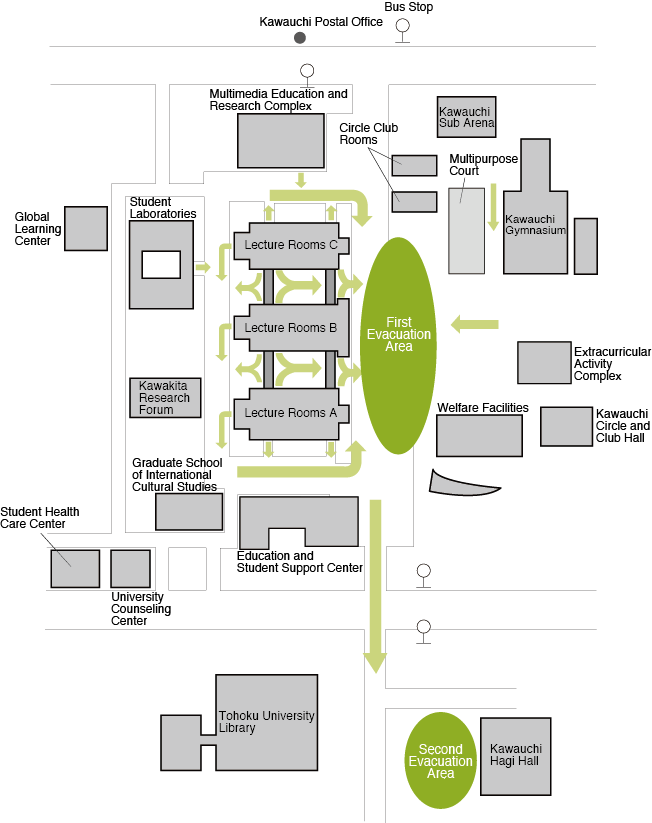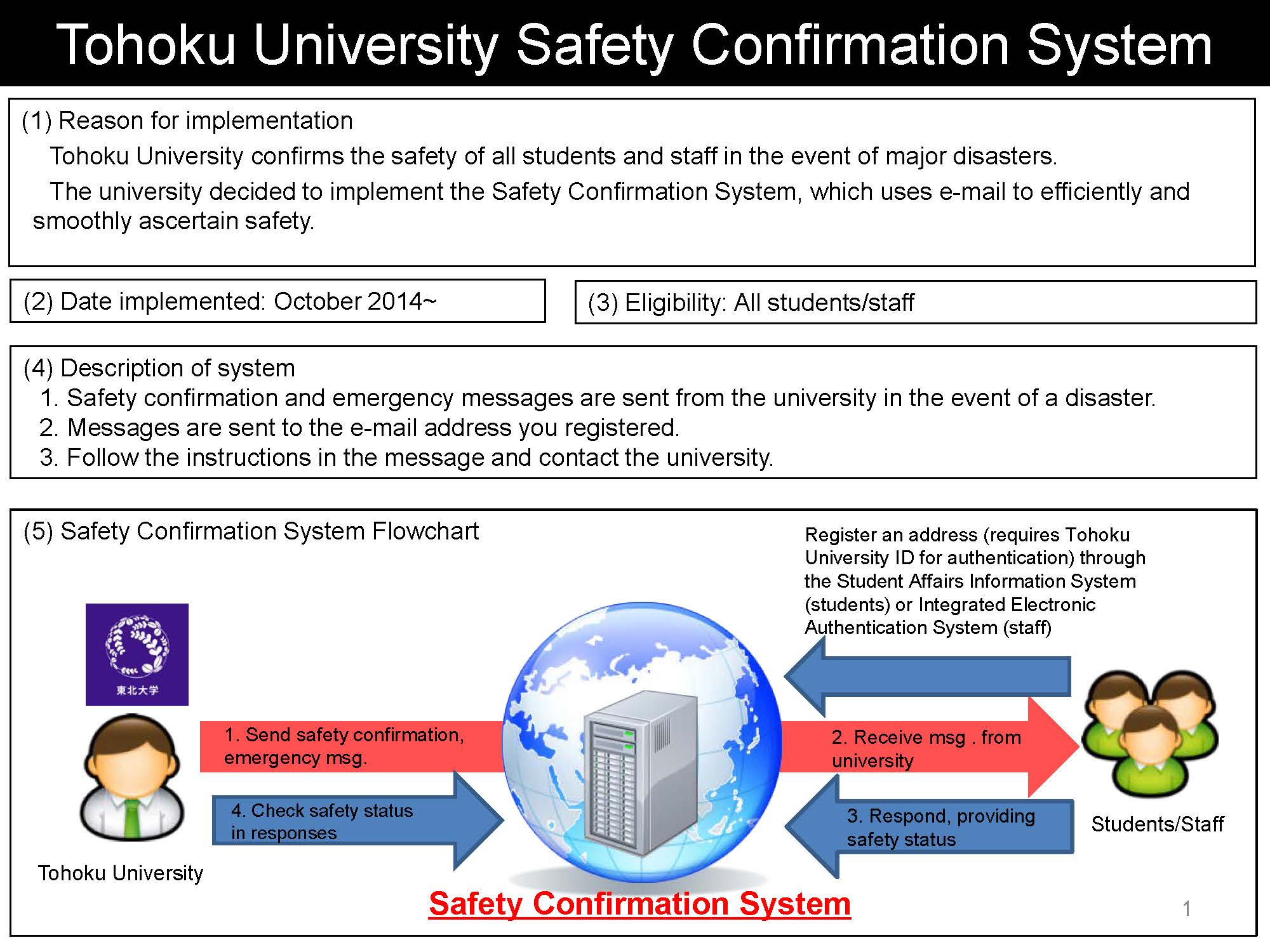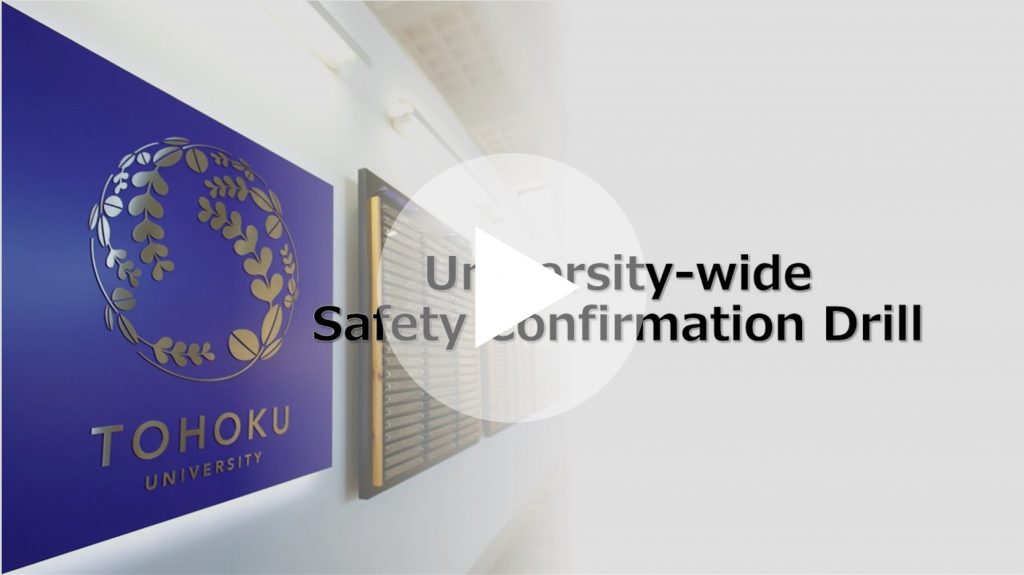Earthquakes are common in Japan. To respond to earthquakes properly, it is important to understand and prepare for them.
Contents
Seismic Intensity Scale
The Japan Meteorological Agency (JMA) uses a seismic intensity scale whose units are called Shindo (震度). The scale starts at 0 (the weakest) and goes up to 7 (the strongest).
What to Do When Earthquake Occurs
The first thing to do is to secure your own safety. If possible, you should take cover under a sturdy table or desk, or else move to a safe space where you are not likely to be hit by falling objects; after finding a safe place, stay there until the tremor subsides. Then, if you were using any sources of fire or heat, turn them off as soon as the shaking calms down.
1. On-campus
- If an earthquake occurs while you are on campus, wait until the tremor subsides, and then move to a designated Primary Evacuation Spot.
- If an earthquake strikes while you are attending a class, follow your teacher’s instructions. Otherwise, move promptly to a Primary Evacuation Spot on your own.
- Shortly after a large earthquake, 安否確認 (An Pi Kaku Nin: “safety confirmation”) will be carried out at the Primary Evacuation Spot, to see who is accounted for.
- Be wary of aftershocks if the earthquake was an especially large one. Keep calm and follow the instructions of the person in charge.
- If an earthquake is particularly severe, transport systems may be disrupted. Follow information on the radio and other media.
- Even if you are going home on foot or by bicycle, be especially cautious as there may be an unpredictable disruption of traffic.
- Do not get too close to the buildings you pass, as objects (pieces of walls, signposts, etc.) may be falling from above.
Evacuation Area
For Kawauchi North campus, the evacuation area can be found as indicated in the below map:


For other campuses, the evacuation area may differ according to department / schools.
For that reason, please be sure to check with your respective departments regarding the evacuation area.
2. Off-campus
- If an earthquake occurs while you are away from campus, secure your safety and wait until the tremor calms down.
- After which the first thing to do is to make sure all flames and electricity are turned off (use the circuit breaker if you can, along with gas valves) to prevent fire.
- If you are close to the coast, evacuate immediately to higher ground, aware that a tsunami may be generated by any violent quake.
- If you are at a place such as a store or a public place, follow the staff’s instructions.
- If at home, move promptly to your Designated Evacuation spot in order to secure your safety and basic supplies.
- Check up on your family and friends’ safety from there. It is highly recommended that you check and confirm the location of your Designated Evacuation spot with your friends, family and / or those who are close to you at the dormitory.
- For a day or two after a large earthquake, mobile telephone networks become jammed. Please refrain from making any calls except those of real importance and urgency.
Tohoku University Safety Confirmation System (安否確認・Anpi Kakunin)
What is it?
It is a system to quickly confirm the safety of all Tohoku University students, faculty and staff members following a large earthquake or other disasters.
All TU students, faculty and staff members are required to report their safety status through the system in case of an emergency.
How does it work?
In the event of natural disaster, safety confirmation and emergency messages will be sent from the university to the e-mail address you registered in the system.
Follow the instructions in the e-mail and share your status with the university
Refer to the below chart and video explanation for more details:
Safety Confirmation System Flowchart
Safety Confirmation System Explanation Video
How to register
For Students
For Faculty Members
Smartphone App
Refer to this page for more details.
Preparation
1. Disaster Drills
- More than once a year, evacuation drills are organized by the university. This is a great opportunity to find out what to do in case of earthquakes, so you are strongly encouraged to participate.
- In order to react appropriately in the event of an earthquake, preparation ahead of time is very important. Let your academic advisors, the Educational Affairs Section at your department and the Student Exchange Division know your contact information (mobile number and email address) so that they can reach you in case of an emergency.
- When a large earthquake occurs, the safety confirmation system will send you an email to confirm your safety. Drills are held regularly and all the university’s members are required to participate in them. During the drill, you will receive an email confirming your safety. Please follow the instruction and respond to it as soon as possible.
2. Preventive Measures/Preparing Goods, Etc.
- Prevent objects such as furniture or electrical appliances from falling over by securing them in place.
- Prepare a survival emergency kit. The following are typical items in the kit: flashlight, batteries, portable radio, lighter, matches, candles, nonperishable food, bottled water, thick cotton gloves, tarpaulin, extra clothes, pens and notepad, first-aid kit, etc.
- Check your emergency survival kit regularly to see if the food’s best-before date has passed, or if any necessary items have gone missing; this way, the kit will be useful when it’s needed.
- Besides the items described previously, ensure that your valuables (passport, Residence / Alien Registration Card, bankbooks, cash, daily medication, if any) are handy with you.
- Keep a list of phone numbers and other contact information for embassies and consulates of your home country so that you can report your safety to them in the event of a disaster.
Featured Video on Disaster Prevention
This video was produced by the International Student Help Desk.
The International Student Help Desk is a support team that consists of Tohoku University students. They provide a variety of support for international students in both academic and daily life, based on their own experiences and from the students’ perspective.


